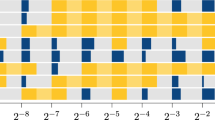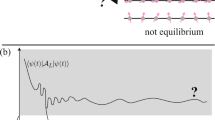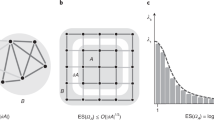Abstract
The spectral gap—the energy difference between the ground state and first excited state of a system—is central to quantum many-body physics. Many challenging open problems, such as the Haldane conjecture, the question of the existence of gapped topological spin liquid phases, and the Yang–Mills gap conjecture, concern spectral gaps. These and other problems are particular cases of the general spectral gap problem: given the Hamiltonian of a quantum many-body system, is it gapped or gapless? Here we prove that this is an undecidable problem. Specifically, we construct families of quantum spin systems on a two-dimensional lattice with translationally invariant, nearest-neighbour interactions, for which the spectral gap problem is undecidable. This result extends to undecidability of other low-energy properties, such as the existence of algebraically decaying ground-state correlations. The proof combines Hamiltonian complexity techniques with aperiodic tilings, to construct a Hamiltonian whose ground state encodes the evolution of a quantum phase-estimation algorithm followed by a universal Turing machine. The spectral gap depends on the outcome of the corresponding ‘halting problem’. Our result implies that there exists no algorithm to determine whether an arbitrary model is gapped or gapless, and that there exist models for which the presence or absence of a spectral gap is independent of the axioms of mathematics.
This is a preview of subscription content, access via your institution
Access options
Subscribe to this journal
Receive 51 print issues and online access
$199.00 per year
only $3.90 per issue
Buy this article
- Purchase on Springer Link
- Instant access to full article PDF
Prices may be subject to local taxes which are calculated during checkout



Similar content being viewed by others
References
Schultz, T. D., Mattis, D. C. & Lieb, E. H. Two-dimensional Ising model as a soluble problem of many fermions. Rev. Mod. Phys. 36, 856–871 (1964)
Hastings, M. B. Lieb-Schultz-Mattis in higher dimensions. Phys. Rev. B 69, 104431 (2004)
Affleck, I., Kennedy, T., Lieb, E. H. & Tasaki, H. Valence bond ground states in isotropic quantum antiferromagnets. Commun. Math. Phys. 115, 477–528 (1988)
Haldane, F. D. M. Nonlinear field theory of large-spin Heisenberg antiferromagnets: semiclassically quantized solitons of the one-dimensional easy-axis Neel state. Phys. Rev. Lett. 50, 1153–1156 (1983)
Golinelli, O., Jolicoeur, Th. & Lacaze, R. Finite-lattice extrapolations for a Haldane-gap antiferromagnet. Phys. Rev. B 50, 3037–3044 (1994)
Anderson, P. W. Resonating valence bonds: a new kind of insulator? Mater. Res. Bull. 8, 153–160 (1973)
Yan, S., Huse, D. A. & White, S. R. Spin-liquid ground state of the S = 1/2 kagome Heisenberg antiferromagnet. Science 332, 1173–1176 (2011)
Balents, L. Spin liquids in frustrated magnets. Nature 464, 199–208 (2010)
Han, T.-H. et al. Fractionalized excitations in the spin-liquid state of a kagome-lattice antiferromagnet. Nature 492, 406–410 (2012)
Jaffe, A. & Witten, E. in The Millennium Prize Problems (eds Carlson, J. A., Jaffe, A. & Wiles, A. ) 129–152, http://www.claymath.org/sites/default/files/yangmills.pdf (Clay Mathematics Institute, American Mathematical Society, 2006)
Rebbi, C. Lattice Gauge Theories and Monte Carlo Simulations (World scientific, 1983)
Turing, A. M. On computable numbers, with an application to the Entscheidungsproblem. Proc. Lond. Math. Soc. 42, 230–265 (1936)
Gödel, K. Über formal unentscheidbare Sätze der Principia Mathematica und verwandter Systeme I. Monatsh. Math. Phys. 38, 173–198 (1931)
Poonen, B. in Interpreting Gödel: Critical Essays (ed. Kennedy, J. ) 211–241 (Cambridge Univ. Press, 2014)
Feynman, R. P. Quantum mechanical computers. Optics News 11, 11–20 (1985)
Kitaev, A.Y., Shen, A.H. & Vyalyi M.N. Classical and Quantum Computation Vol. 47 of Graduate Studies in Mathematics Ch. 14.4 (American Mathematical Society, 2002)
Kempe, J., Kitaev, A. & Regev, O. The complexity of the local Hamiltonian problem. SIAM J. Comput. 35, 1070–1097 (2006)
Oliveira, R. & Terhal, B. M. The complexity of quantum spin systems on a two-dimensional square lattice. Quantum Inf. Comput. 8, 900–924 (2008)
Aharonov, D., Gottesman, D., Irani, S. & Kempe, J. The power of quantum systems on a line. Commun. Math. Phys. 287, 41–65 (2009)
Gottesman, D. & Irani, S. The quantum and classical complexity of translationally invariant tiling and Hamiltonian problems. In Proc. 50th Annu. Symp. Found. Comput. Sci. 95–104 (IEEE, 2009)
Bernstein, E. & Vazirani, U. Quantum complexity theory. SIAM J. Comput. 26, 1411–1473 (1997)
Nielsen, M. A. & Chuang, I. L. Quantum Computation and Quantum Information Ch. 5.2 (Cambridge Univ. Press, 2000)
Wang, H. Proving theorems by pattern recognition. Bell Syst. Tech. J. 40, 1–41 (1961)
Robinson, R. M. Undecidability and nonperiodicity for tilings of the plane. Invent. Math. 12, 177–209 (1971)
Cardy, J. (ed.) Finite-size Scaling (Elsevier, 2012)
Cardy, J. Scaling and Renormalization in Statistical Physics (Cambridge Univ. Press, 1996)
Cubitt, T. S., Perez-Garcia, D. & Wolf, M. M. Undecidability of the spectral gap. Preprint at http://arXiv.org/abs/1502.04573 (2015)
Bravyi, S., Hastings, M. & Michalakis, S. Topological quantum order: stability under local perturbations. J. Math. Phys. 51, 093512 (2010)
Michalakis, S. & Zwolak, J. P. Stability of frustration-free Hamiltonians. Commun. Math. Phys. 322, 277–302 (2013)
Acknowledgements
T.S.C. thanks IBM. T. J. Watson Laboratory for their hospitality, and C. Bennett in particular for discussions about this work. T.S.C., D.P.-G. and M.M.W. thank the Isaac Newton Institute for Mathematical Sciences, Cambridge for their hospitality during the programme “Mathematical Challenges in Quantum Information”, where part of this work was carried out. T.S.C. is supported by the Royal Society. D.P.G. acknowledges support from MINECO (grant MTM2011-26912 and PRI-PIMCHI-2011-1071), Comunidad de Madrid (grant QUITEMAD+-CM, ref. S2013/ICE-2801) and the European Research Council (ERC) under the European Union’s Horizon 2020 research and innovation programme (grant agreement no. 648913). This work was made possible through the support of grant no. 48322 from the John Templeton Foundation. The opinions expressed in this publication are those of the authors and do not necessarily reflect the views of the John Templeton Foundation.
Author information
Authors and Affiliations
Contributions
All authors contributed extensively to the paper.
Corresponding author
Ethics declarations
Competing interests
The authors declare no competing financial interests.
Supplementary information
Supplementary Information
This file contains Supplementary Text and Data 1-7, Supplementary Figures 1-5 and additional references. (PDF 750 kb)
Rights and permissions
About this article
Cite this article
Cubitt, T., Perez-Garcia, D. & Wolf, M. Undecidability of the spectral gap. Nature 528, 207–211 (2015). https://doi.org/10.1038/nature16059
Received:
Accepted:
Published:
Issue Date:
DOI: https://doi.org/10.1038/nature16059
This article is cited by
-
The undecidable charge gap and the oil drop experiment
Pramana (2024)
-
Gödel’s Undecidability Theorems and the Search for a Theory of Everything
International Journal of Theoretical Physics (2024)
-
Some problems in density functional theory
Letters in Mathematical Physics (2023)
-
Undecidable problems in quantum field theory
International Journal of Theoretical Physics (2023)
-
Stability of the Spectral Gap and Ground State Indistinguishability for a Decorated AKLT Model
Annales Henri Poincaré (2023)
Comments
By submitting a comment you agree to abide by our Terms and Community Guidelines. If you find something abusive or that does not comply with our terms or guidelines please flag it as inappropriate.



